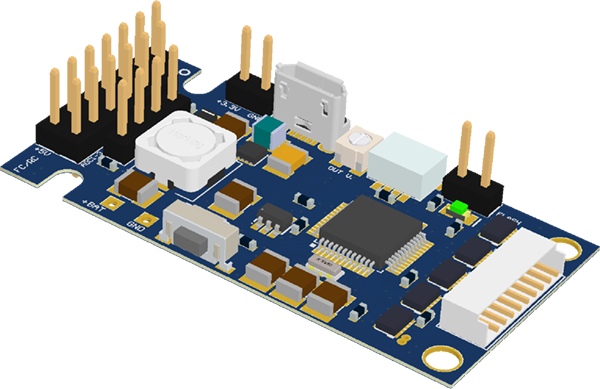BaseCam SimpleBGC 32-bit Tiny Rev. A, B
This controller is a smaller version of SimpleBGC 32-bit 3-axis stabilization. It is designed for building gimbals for small cameras.
/!\ Revision A is discontinued. Revision B is produced but not recommended for new design. Replacement is Tiny Rev.C
Features
Built-in IMU sensor, can be used as a second frame sensor or as a main sensor.- Possibility to regulate voltage from 6 up to 11 V and connect small motors despite current of a battery.
- Has the same sockets as the full size SimpleBGC 32-bit.
- Possibility to connect optional Bluetooth module.
Comparing revisions A and B
SimpleBGC 32bit Tiny controller revision B has the following improvements compared to revision A:
- Smaller than the previous version: dimensions are 25×40 mm, height is 7mm (pin headers are not installed)
- Current capabilities were extended:
- +5V line can provide up to 1A continuous current (that is enough to power GoPro camera), and up to 2A instant current *
- +3.3V line can provide up to 500 mA continuous current and 1A instant current *
- Input voltage range was extended to 1s 6s (3.7V–25V)
- USB-UART onboard converter simplifies PC connection, fewer problems with drivers compared to the previous version
* Total current taken by the 5V load, 3.3V load, and motor drivers, should not exceed 2A. Proper thermal dissipation is required.
Capabilities of the controller
Possibility to manage the system on different platforms
Desktop systems: Windows, macOS, Linux. Possibility to update the firmware of the controller(through the GUI).
Smartphones: Android and some control from 3rd party vendors for Apple's iOS product (iPhone and iPad).
Open Serial API
Open programming interface for development of external control modules — both for software configuration and control of the board and for communication with various electronic devices.
Automatic tuning of PID parameters
Automatic tuning of PID parameters will allow you to quickly prepare the system for work either at the initial settings or at changed conditions.
Support of systems with various configurations
Flexible customization of the sensor orientation.
Support for a wide range of motors of various configurations and sizes.
Support for two sensors
The system works with either one or two IMU sensors. The use of two sensors improves stability and accuracy.
Optimized control algorithm
The algorithm uses no more than 30% of CPU power and has a large reserve for future opportunities.
Operation of the system at any angle
The system operates at any inclination of the stabilizer frame, and has several modes of operation: Briefcase (90 degrees rotation ROLL) and Upside Down as well.
Different algorithms of follow mode
Flexible configuration of the follow mode for each axis. Automatic switching of horizon axis mode from lock to follow in case of persistent camera tilt.
Adaptive
Up to five user-configurable modes of system operation with a toggle button
Support of a wide range of external control protocols
Futaba, Spektrum, 5x PWM, Sum-PPM, 3 ADC.
Flexible configuration allows for control of any functions of the system (every parameter that the system uses is configurable).
The system can decode Futaba / Spectrum and provide PWM to control servo drives.
Battery voltage drop compensation
Battery voltage drop compensation ensures proper control of the drive motors during the whole life of the battery.
Different versions of the controllers for different needs
The licensing system allowed our partners to launch different versions of controllers for a wide range of applications: from compact controllers for stabilizers of light cameras to powerful ones for the stabilization of heavy units.
Ongoing work to improve the system
BaseCam Electronics is working closely with the developers of end devices, which allows us on the basis of feedback, to continuously improve the stabilization algorithms and expand the capabilities of the system within a single version of the controller.
/!\ Important notes
A. Some versions of this board may have minor error in labeling outputs: On boards having the
B. Some versions of the full size 32-bit controller board can have a problem with the spektrum port (see that boards description for more information): At present we are not seeing the problem with this board, though for aerial vehicles where operation is critical it may be advisable nonetheless to make similar changes to account for the possibility- in particular the advisory for the other board is to power the spectrum satellite receiver separately (not from the board power).
Specifications
| Revision B | Revision A | |
 |
 |
|
| Size of the board: | 40×25 mm | 50×25 mm |
| Weight | 5.84 g | 8.05 g |
| Power supply voltage: | 3.7–25 V (1s 6s LiPo) |
7.4–16.8 V (2s 4s LiPo) |
| Maximum motor current: | 1 A | 600 mA |
Downloads
Support
Type your question or comment below. Answer will be sent at your E-mail within 24 hours on workdays.
USB Drivers for PC Connection
If controller being connected to the USB port, is not recognized as COM-port, most probably you need to install or update drivers for CP210x chip. You can download driver for your OS from the manufacturer of CP210x.
AN IMPORTANT NOTE: The latest version (6.7.4) of driver for Windows may cause problems with delay in data transmission, visible as a big lag of the GUI. In this case, install version 6.7.2 of the driver, which had no such problems.
Remarks
- AUX1 and AUX3 labels may be mixed up on some boards.






